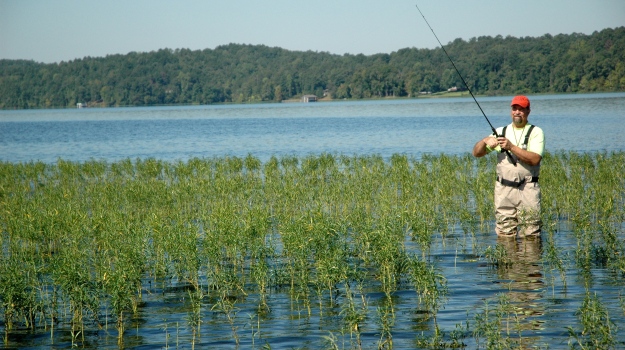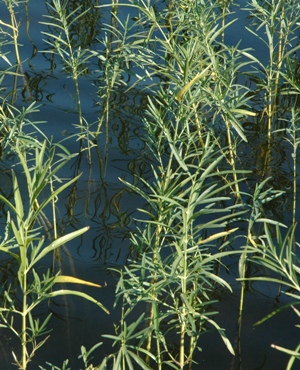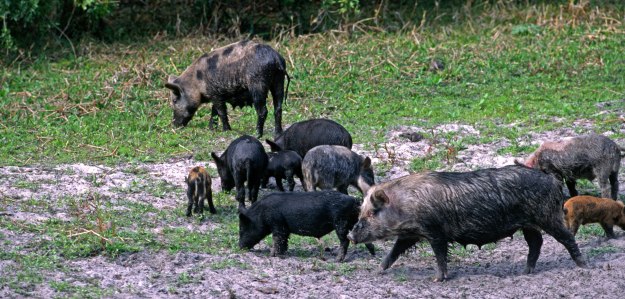
By Don C Keller | American Sport Fish
Fisherman love to fish around structure, particularly structure that is visible such as stumps, blown down trees and grass beds.
Aquatic vegetation in the form of grass beds can sometimes go from being the fisherman’s friend by providing cover to harming the fishery by almost completely taking over the lake.
One type of vegetation that has all of the desirable characteristics required to provide good fishing with out over expanding is WATER WILLOW (Justicia americana). Water willow is not actually a willow tree that grows in the water but rather an aquatic plant that grows throughout the eastern United States. It grows in the shallow water margins of streams, rivers, lakes, and ponds. Water willow is aptly named because it has leaves which resemble those found on willow trees. The narrow lance shaped leaves are arranged on opposite sides of erect stems. The stems can be up to 38 inches tall. The plants have flowers that are white to violet in color that bloom from May to October.
Water willow grows and forms colonies in shallow water. It will not survive if it is completely covered by water. This is an advantage since it will not become too widespread over the entire body of water, only the shoreline or shallow humps.
 The plants spread by a vigorous root system and also by seed. The extensive root system makes this plant a good species for use in stream bank and shoreline erosion control. The root system holds the soil in place and reduces erosion by wave action and current. The erect stems will flatten in current, and this helps maintain gravel bars in streams which have water willow colonies. Smallmouth bass conservationists in Illinois, Kansas and Missouri have been planting water willow in selected streams to improve habitat for smallmouth for the last several years.
The plants spread by a vigorous root system and also by seed. The extensive root system makes this plant a good species for use in stream bank and shoreline erosion control. The root system holds the soil in place and reduces erosion by wave action and current. The erect stems will flatten in current, and this helps maintain gravel bars in streams which have water willow colonies. Smallmouth bass conservationists in Illinois, Kansas and Missouri have been planting water willow in selected streams to improve habitat for smallmouth for the last several years.
The erect nature of the stems provide excellent habitat for fish and small aquatic organisms and it allows water exchange with current and wave action. This water flow and the access of small fish reduce the possibility that mosquitoes will find suitable breeding areas in water willow. This is in contrast to many aquatic plants that form dense mats and stagnant water that are prime habitat for mosquitoes.
In Alabama, especially along the Coosa river system, local fishermen refer to water willow as “bass grass”. When the BASS Master’s Classic was held on Lay Lake, a reservoir on the Coosa system, many of the professional fishermen were taking large strings of fish from the “bass grass”. In the spring as the water warms, crappie will move into the grass to feed and spawn among the open stems. As the water continues to warm, bluegill will move in the grass to feed on small insects and other aquatic organisms
In the event water willow needs to be removed it is relatively easy to control with aquatic herbicides. Good results can be obtained by spraying with either 2,4-D, diquat or glyphosate.
If you desire to establish grass beds in your own lake, there are a limited number of nurseries that will have containerized plants of water willow. Once these plants are established, they will be restricted to the shoreline margins or shallow islands and stands can be easily controlled once they are established.
There are many advantages of having grass beds in your lake. For me, the anticipation of a strike as a spinner bait is buzzed through the grass is what makes bass fishing special.






























